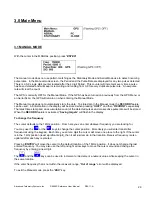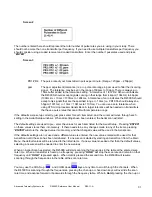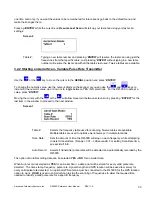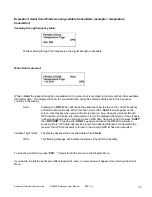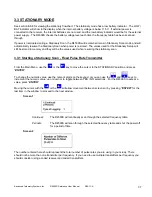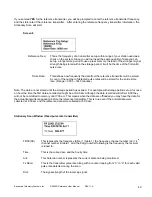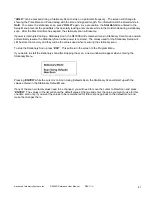
Advanced Telemetry Systems, Inc. R4500S Reference User Manual R05-11-A
26
2.5 Channel Delay
During a stationary scan, when switching to a new frequency the “Channel Delay“ will be activated. The available
delay time is 0-5000 milliseconds. The default Channel Delay time is 1000 milliseconds (1 second). The purpose of
the Channel Delay is to filter out unwanted noise pulses when switching frequencies. The R4500S filters out
unwanted noise pulses during the Channel Delay time by ignoring all pulses detected during the entered time, 0 –
5000 milliseconds. The scan time of each frequency does not start until the Channel Delay time has expired.
This adjust is available for cases where the noise level changes significantly when frequency channels are
changed. The R4500S measures the average background noise level and adjusts the detection level accordingly. If
the background noise level changes dramatically between channels, more time is needed to adjust to the new
threshold level. When using multiple antennas the system monitors all antennas for the first two seconds (Time Out
setting), if there are no pulses present, the search on all antennas is terminated and any other antennas are
skipped. This saves scan time and allows all channels to be searched more often.
To determine if extra delay is needed, cycle through the frequency table with no transmitters present to determine
if noise pulses cause the receiver to cycle through the multiple antenna sequence. If the receiver scans through all
antennas on several or all frequency channels even with no signal present; you may want to increase the Channel
Delay time. If noise pulses are present, and the multiple antenna scanning sequence does not start, the Channel
Delay time is set correctly.
Setting the Channel Delay time longer gives more time for the R4500S to set a new threshold and optimize
sensitivity while at the same time ignoring noise. Setting it longer than necessary means the additional delay will be
added to every frequency channel scanned also increasing the time for all channels to be scanned. Thus the goal is
to set the delay so most, but not necessarily all noise pulses on every channel are ignored. Occasionally high level
noise will still pass no matter how long the delay is made.
Example of scan times with no transmitters present: Number of antennas used = 2. Time out = 3 seconds. Scan
time = 10 seconds. Number of frequencies used in table scanned = 10.
If the noise level is higher than the noise threshold level the R4500S has set, the noise will produce signal pulses
and the receiver will think transmitters are present and then cycle through the individual antennas. With no
transmitters in the area, but with noise pulses indicating possible presence of transmitters, the time for a scan of the
complete frequency table will be: Scan Time of antenna 0 + Time Out of antenna 1 + Time Out of antenna 2 = 10 +
3 + 3 = 16 seconds. For the10 frequencies in the table, the total scan time will be 160 seconds. (When an individual
antenna is selected, the noise level decreases and there should not be any noise pulses produced)
When using the default Channel Delay of 1000 milliseconds and there are no noise pulses above the threshold nor
are any transmitters present; the time of the frequency table scan will be: Channel Delay time + Time Out of
antenna 0 = 1 + 3 = 4 seconds. For the10 frequencies the total scan time would be 40 seconds. With the Channel
Delay set correctly, scan times can be reduced by allowing time for the R4500S to set the correct noise threshold
level.
Enter a numeric number from 0 to 5000 and press
“ENTER”
.
Pressing
“ENTER”
or
“ESC”
will return the screen back to the “Setup Menu”.


















